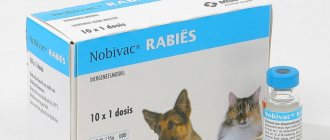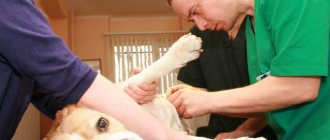Veterinarians strongly recommend vaccinating pets during childhood. Despite this, many owners refuse this procedure. Some are stopped by the erroneous belief that animals that do not go outside are invulnerable. Others are fully aware of the risks, but are very worried about the reaction to vaccination against rabies and other diseases in cats.
The benefits and harms of vaccination
First, it’s worth understanding the pros and cons of vaccination. With a significant preponderance of benefits, possible complications fade into the background.
How does the vaccine work?
After vaccination, the cat receives immunity, since the administered vaccine stimulates the production of antibodies to fight the virus. The injection solution is based on a killed or weakened pathogen of one or more deadly diseases.
Thanks to a milder effect, the body has time to neutralize the pathogenic agent. Information about it is saved, so in the event of a real infection, the immune system immediately fights back, excluding the death of the animal from complications.
Despite the effectiveness of this method, such immunity does not last forever. It is necessary to vaccinate pets every year, since after this time the “immune memory” weakens. Repeated injection allows you to refresh memories and increase your defenses.
What happens if you don’t vaccinate an animal?
Thanks to immunity, 90% of vaccinated cats immediately fight back the pathogen even at the infection stage. The remaining 10% still get sick, but suffer the infection in the mildest form and quickly recover.
At the same time, an unvaccinated pet is extremely vulnerable. When confronted with a virus, it is sure to become infected and, if its body does not have time to pick up a “master key” against the invader, it dies.
Lack of contact with other animals and suppression of walking on the street do not guarantee protection from pathogenic microorganisms. They can be brought into the house on clothes, shoes and even on unwashed hands.
Refusal to vaccinate worsens the epidemiological situation, increasing the number of infections, and imposes restrictions on overexposure. It is dangerous for owners of unvaccinated pets to pick up strays or take in animals for temporary housing.
It is equally important to note the absence of a veterinary passport documenting all administered vaccines. Without it, it is impossible to move to another country, become a participant in a cat show, or try your hand at breeding.
Symptoms of rabies in humans after a cat bite
People most often become infected from domestic animals. At the same time, the clinical picture of the disease directly depends on where exactly the person was bitten by a rabid cat or dog - if the virus entered, say, through a wound on the leg or face, it will develop in the human body at different rates.
Symptoms of rabies in humans after a cat bite may appear within 10 days, but may not be felt for several months, and in rare cases even for several years.
When infected with a virus, the disease can occur in two forms, which in the medical literature are traditionally called violent (everyone has heard about it) and paralytic.
Violent form
In the initial stage (it lasts 1–3 days), a person feels general weakness, headache accompanied by fever, muscle and throat pain, dry mouth and loss of appetite, as well as cough, which is similar to the course of any viral infection.
There is a burning sensation, itching and pain at the site of the bite. The patient feels fear, depression, insomnia, and nightmares appear. Visual and olfactory hallucinations often occur.
The second stage is characterized by increased excitability - a person is constantly bothered by something, worried, he cannot find a place for himself. Attempts to drink are accompanied by a spasm of the muscles of the larynx, and later even one glance at water (no matter dripping, pouring or in a glass) causes horror in a person - hydrophobia appears.
Breathing is noisy, painful, accompanied by convulsions. Sweating and drooling are pronounced. Irritability develops into aggression, during attacks of which a person behaves violently: he begins to rush around, scream, destroy everything around, rush at people (both acquaintances and strangers), showing great strength. This lasts about 2–3 days.
We recommend reading: Can You Cure a Skin Infection in a Dog?
At the last stage, the patient becomes psychologically better - he calms down, anxiety and fear of hydrophobia go away. The temperature rises above 40°C, after which convulsions and paralysis of the whole body occur, and the patient’s consciousness fades. Death occurs as a result of respiratory or cardiac arrest.
Paralytic form
In the paralytic form, the disease develops longer and is not as pronounced: muscle paralysis gradually occurs, starting from the site of the bite, after which the person falls into a coma and slowly dies.
The forms of the disease and symptoms in cats are somewhat different, which you can read about in our article about rabies in cats.
What diseases are cats vaccinated against?
All vaccinations are divided into mandatory and additional. The first ones do not depend on the place of residence and conditions of detention. These include vaccines against rabies, calcivirosis, rhinotracheitis and panleukopenia.
The latter are recommended only in certain regions and depend on the epidemiological situation. This includes vaccination against chlamydia and leukemia.
Rabies
Rabies is on the mandatory list in all countries of the world. Rabivirus is dangerous not only for animals, but also for humans. The infection it causes affects all parts of the central nervous system and cannot be treated, so if an unvaccinated pet becomes infected, it is euthanized.
Calcivirosis
Calcivirosis is accompanied by conjunctivitis and pneumonia, which reduce the body's defenses. The disease is often complicated by a secondary infection, causing death in 80% of those infected.
Rhinotracheitis
Rhinotracheitis, or herpesvirus, affects the upper respiratory tract, causing the development of bronchial pneumonia. It is especially severe in kittens, dying in 20% of cases.
Panleukopenia (distemper)
The distemper virus attacks the intestines, lungs, skin and central nervous system alternately or simultaneously. Even after recovery, loss of vision, lameness and regular epileptic seizures are noted.
Chlamydia
Dangerous for animals with low immunity: kittens, elderly or weakened by chronic diseases pets. Chlamydia causes inevitable death when brain cells are damaged and can be transmitted to humans, while being very different from the sexual form of the disease.
Leukemia
This cancer provokes the development of lymphosarcoma - a malignant lump formed from lymphatic tissue. The virus is very fragile and dies quickly in the environment, so it is transmitted only through close contact. Vaccination against leukemia is recommended for breeding animals, shelter residents and all cats going outside.
What is the gag reflex
In purring cats, vomiting occurs frequently - this is a manifestation of the normal functioning of the cat's gastrointestinal tract. But sometimes the gag reflex becomes a symptom of a serious illness.
Vomiting is a spontaneous action of the body. A special center located in the animal’s brain gives the command to eject the contents of the intestines. When a cat feels bad, it vomits - its body protects itself by removing poisons, toxins, excess food and foreign bodies that have entered the stomach.
But gagging is the tip of a huge iceberg. The brain center gives orders and is activated for other reasons (illness, increased intracranial pressure, gastrointestinal pathologies). Sometimes the cat vomits in the car - when the cat is shaken violently, its vestibular apparatus cannot cope and sends a danger signal to the brain. The result is vomiting.
Cat vomiting is a universal and multifaceted symptom. The owner of a furry cat needs to know everything about this reflex in order to figure out in time what is happening to the pet and respond competently.
Vaccine selection
The vaccine allows you to protect against only one (monovaccine) or several (polyvaccine) strains of the virus. The most effective include complex drugs with a weakened viral code, reducing the number of injections and maximally stimulating the production of antibodies. The owner is also asked to choose a manufacturer.
Domestic brands
Injection solutions from domestic brands cost less than their foreign counterparts and are rarely available for sale. They can be purchased at any Russian veterinary clinic or veterinary pharmacy.
Multifel-4
The most popular drug that protects against calcivirosis, rhinotracheitis, plague and chlamydia. Does not cause side effects, except for slight swelling and a mild allergic reaction.
Rabikan
Used to develop immunity against rabivirus (rabies). Often accompanied by complications in kittens and adult cats with low weight.
Leominor
Suitable for immunization against leukemia and can be used in conjunction with Multifel-4. According to the results of clinical trials, vaccinated animals retain adequate behavioral reactions, activity and appetite.
Foreign stamps
Despite the high cost, it is more popular than domestic drugs. This is due to less pronounced side effects.
Nobivac
The Dutch vaccine is suitable even for kittens and is available in several versions: Tricat and Rabies. The first option protects against all infections from the mandatory list, except rabies, and the second – against 4 diseases at once, including rabies.
Quadricat
Recommended for pregnant cats and kittens. Available in 2 forms: liquid (calcivirosis + rhinotracheitis) and dry (rabies + panleukopenia). Before use, they are mixed and administered together.
Felocell
American analogue of the domestic Multifel-4. The complications that arise are associated with the chlamydial component. If your pet is not at risk, then it is much safer to choose a trivalent drug without vaccination against chlamydia.
PureVax
French analogue of Leominor. In addition to injection solutions against leukemia, the manufacturer produces 2 more forms of the drug recommended for mandatory vaccination.
Non-dangerous consequences of vaccination
After vaccination, cats often experience side effects. Such a reaction of the body is typical for any intervention and should not always cause concern to the owner.
Lethargy and loss of appetite
Low fever, passivity and lack of interest in favorite treats are observed for no more than 4 days (depending on the vaccine). They go away on their own after the active production of antibodies, which overloads the body, ceases.
Lump on the withers
In addition to the virus, most vaccines contain an adjuvant, a compound that enhances the immune response. It provides blood flow to the injection site and causes a mild inflammatory reaction. The swelling disappears within a week, but some anti-rabies compounds can provoke the development of a lump that lasts a long time - up to several months.
Temporary lameness
The occurrence of lameness is typical when the nerve is damaged during an intramuscular injection. Due to pain, your pet may limp for about 3 weeks. Otherwise his health remains satisfactory.
The rabies virus as it is
The rabies virus (in Latin Rabies virus) is very insidious and easily passes into the human body from the saliva of affected animals - for this it only needs damage to the skin, inevitably received by a person through a bite or for some reason previously.
The virus multiplies in nervous tissue and migrates along nerve pathways from the site of infection to the brain at a speed of about 3 mm per hour. Therefore, particularly dangerous places for bites are the hands and head, from where the virus can very quickly penetrate the brain. Having reached the spinal cord and brain, it causes severe inflammation with the death of tissue areas.
Photo of rabies virus
Dangerous complications
Most severe side effects are associated with neglect of preparatory measures. If they appear, it is recommended to contact a veterinarian.
Allergic reaction
If there is an individual intolerance to the components included in the composition, a mustachioed patient may experience vomiting, lacrimation, diarrhea, itching, baldness and even anaphylactic shock, which can lead to suffocation. For this reason, doctors recommend not leaving the veterinary clinic for 1 hour after the injection in order to quickly help the animal and prevent complications - especially if the vaccine is used for a specific pet for the first time.
Constant lameness
If a large nerve plexus is damaged, partial or complete paralysis may develop. If your pet does not get up on its paws for more than 2 days, seek help. With timely treatment, limb mobility returns.
Sarcoma (oncology)
One of the most dangerous and rare complications is the appearance of a cancerous tumor at the injection site. If the lump lasts longer than a week, looks too large, or is gradually getting larger, be sure to consult your veterinarian. In addition to the neoplasm, the cause of the swelling may be an abscess caused by the ingress of pathogenic microorganisms.
Kidney diseases
Excessive exposure to PureVax and other products containing feline kidney cells causes an autoimmune disease. Immune cells take up arms not only against the virus, but also against native nephrons, provoking the development of kidney failure.
Mild course of the disease
It is important to clarify here that the vaccine is not a cure, but only a means of prevention. A vaccinated pet will get the same infection as an infected unvaccinated one. The only difference is that the first one tolerates it easier. Sometimes the symptoms are so weak that the owner does not even notice them.
How to prepare your pet
Any vaccination is tolerated differently by animals, especially by very young kittens. Therefore, a kitten should be vaccinated against rabies after appropriate preparation and observation :
- 2-3 weeks before vaccination, the baby must be dewormed;
- treat against parasites (fleas, ticks);
- a few days before vaccination, monitor the kitten’s health (its appetite, temperature, etc.).
The last point is no less important than the first two, because the veterinarian will not vaccinate if the kitten has:
- there is or has just been an infectious disease;
- chronic diseases have worsened;
- increased (even slightly) temperature;
- there is an individual intolerance to the components of the vaccine;
- poor general condition, there are signs of health problems.
Also, do not rush into vaccination if:
- teeth are cutting through (usually this occurs at the age of 4-7 months);
- recently underwent surgery;
- antibiotic therapy was carried out.
If everything is fine with your pet’s health and the preparation was successful, it’s time to come to the clinic for vaccination.
Vaccination rules
After receiving the first passive immunity, vaccination is carried out once a year. A longer break (3 years) is typical only for vaccination against rabies, although in Russia it is strongly recommended to vaccinate pets against rabovirus more often - annually. To avoid unpleasant consequences, you should carefully read the basic rules and contraindications.
At what age should I start?
Babies are protected from infections thanks to colostrum containing their mother's antibodies. Passive immunity lasts up to 4 months, but if breastfeeding ends at 2 months, the first vaccination is given at this age.
At 2-2.5 months, kittens are vaccinated against all diseases from the mandatory list, except rabies. After 3-4 weeks they are revaccinated to consolidate the result. If by this time they reach 3 months, then a polyvalent solution containing a weakened rabies virus is used for vaccination.
Preparing for vaccination
Before the procedure, the mustachioed pet is taken to the veterinary clinic for examination and tests to exclude hidden infections. 1.5-2 weeks before vaccination, deworming is carried out to prevent a sharp weakening of the immune system due to sudden infection with helminths. Contact with other animals is temporarily prohibited.
Strict adherence to preparatory measures reduces the likelihood of dangerous complications to 0.5-1%. If alarming symptoms appear, the planned procedure is postponed until complete recovery.











